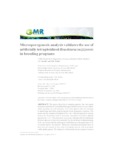Please use this identifier to cite or link to this item:
http://www.alice.cnptia.embrapa.br/alice/handle/doc/1056860| Title: | Microsporogenesis analysis validates the use of artificially tetraploidized Brachiaria ruziziensis in breeding programs. |
| Authors: | PAULA, C. M. P.  FIGUEIREDO, K. G.   SOUZA SOBRINHO, F. de   BENITES, F. R. G.   DAVIDE, L. C.   TECHIO, V. H.   |
| Affiliation: | C.M.P. Paula, UFLA; K. G. Figueiredo, UFLA; FAUSTO DE SOUZA SOBRINHO, CNPGL; FLAVIO RODRIGO GANDOLFI BENITES, CNPGL; L. C. Davide, UFLA; V. H. Techio, UFLA. |
| Date Issued: | 2016 |
| Citation: | Genetics and Molecular Research, v. 15, n. 3, gmr.15038737, 2016. |
| Description: | The genus Brachiaria contains species that have great economic importance in the Brazilian agricultural sector, as they enable cattle ranching on acid and poor soils with species that are resistant to spittlebugs and form crop-livestock-forest integration systems. The genus mainly consists of tetraploid (2n = 4x = 36) and apomictic species such as B. decumbens and B. brizantha. Sexuality is found in diploid species (2n = 2x = 18) such as B. ruziziensis. Interspecific hybridization between species of interest is possible by the artificial tetraploidization of B. ruziziensis and the subsequent hybridization with genotypes of B. brizantha and B. decumbens. Therefore, tetraploidized plants have to have normal meiosis or low rates of irregularities, as well as produce viable pollen grains. The objective of this study was to compare meiosis and pollen grain viability and morphology in artificially tetraploidized B. ruziziensis with that of descendants generated from crossing and selfing. The frequency of meiotic abnormalities ranged from 4.43 to 11%, and pollen viability ranged from 61 to 85%. Abnormalities were detected from prophase I to the tetrad stage with a variable frequency between the genotypes. The meiotic behavior of the artificially tetraploidized plants was little affected, and the pollen viability of the genotypes was high. Regarding pollen grain ultrastructure, there were no variations or morphological changes in the different genotypes. The genotypes have meiotic stability and high pollen viability, and can be incorporated into Brachiaria breeding programs. |
| NAL Thesaurus: | breeding forage meiosis polyploidy |
| Keywords: | Pollen grain |
| DOI: | https://doi.org/10.4238/gmr.15038737 |
| Type of Material: | Artigo de periódico |
| Access: | openAccess |
| Appears in Collections: | Artigo em periódico indexado (CNPGL)  |
Files in This Item:
| File | Description | Size | Format | |
|---|---|---|---|---|
| Cnpgl2016GenMolResMicrosporogenesis.pdf | 717.1 kB | Adobe PDF |  View/Open |









